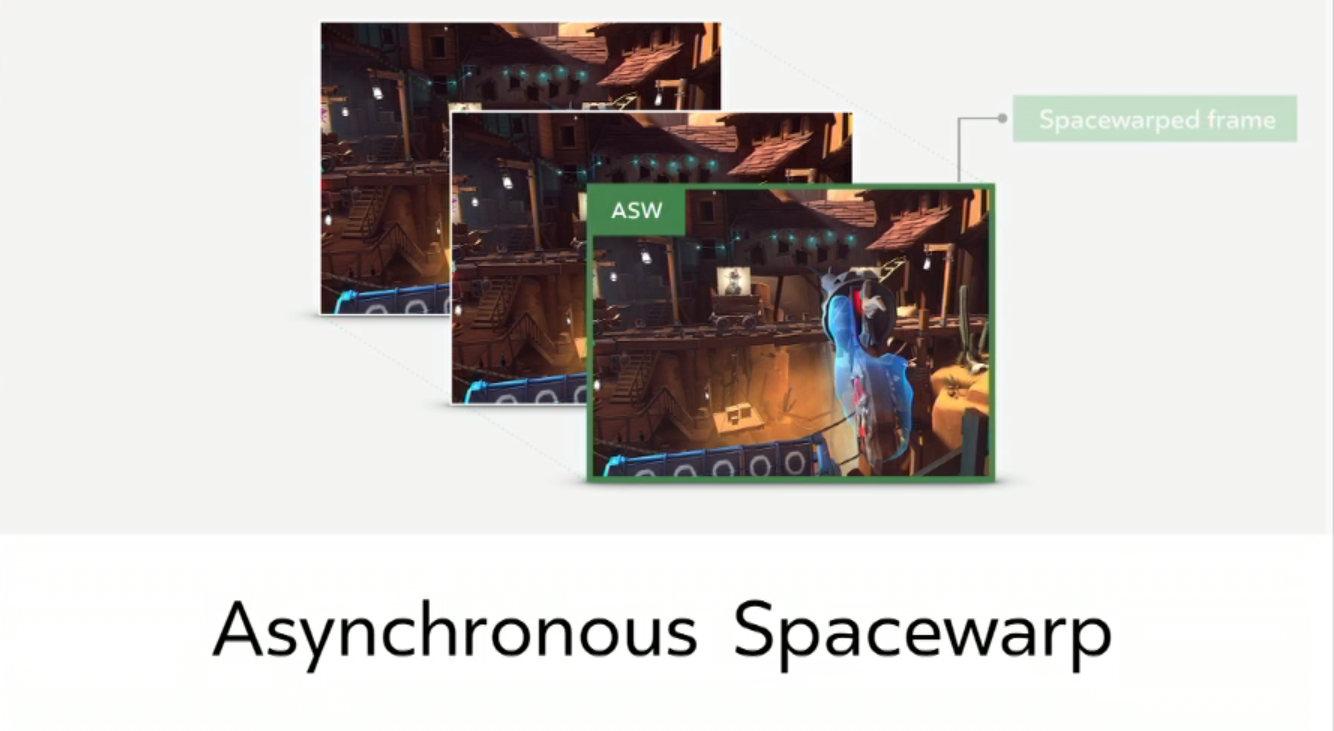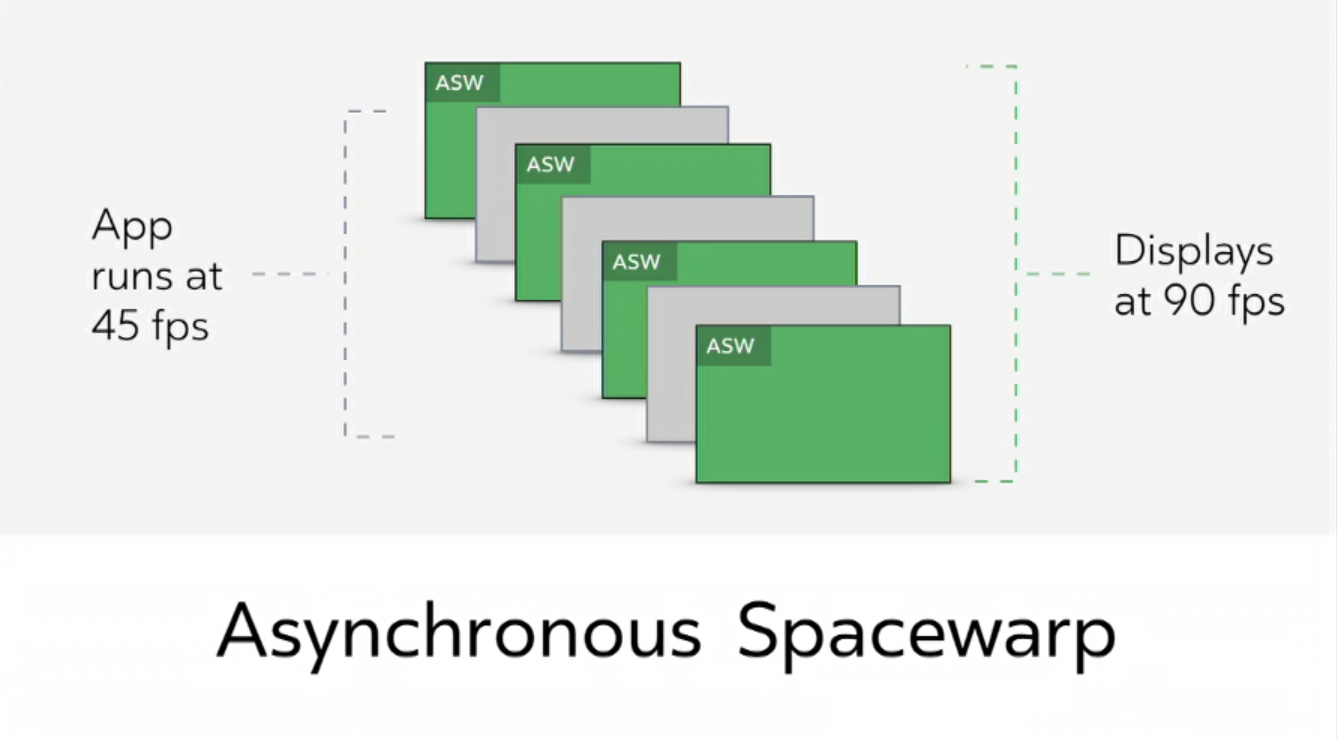Oculus Reveals Asynchronous Spacewarp, Lowers VR Minimum Spec
The big news from Oculus at OC3 isn’t the launch date and price for Touch. The biggest bombshell of the event is Asynchronous Spacewarp, which lowers the bar for VR-ready PCs to a range anyone can afford.

Virtual reality is an amazing technological achievement that has the potential to change many aspects of our lives, but before that can truly happen, VR must achieve wide adoption. Today, the high cost of VR headsets and the supporting hardware that you need to operate one is one of the biggest factors preventing most people from investing in the new medium. $1500 for an entry level VR-ready PC and Oculus headset is cheap enough for enthusiasts and early adopters with a little bit of money to burn, but it's too much for the average person—even the average gamer.
Oculus had good reason to keep the performance specifications high when it launched the Rift in May. Most PC gamers target 60 frames per second as their performance threshold in their favorite games, and an overwhelming number of those gamers still play on 1080p panels. The Rift has two 1080x1200 (2160x1200) displays, and it requires 90 frames per second at all times for a comfortable experience.
Oculus had to invent Asynchronous Timewarp (ATW) so that it could certify GTX 970 and R9 290/390 GPUs for VR. Brendan Iribe, CEO of Oculus, said that without ATW, “apps would drop more than 11% of their frames.” This would make your VR experience unpleasant, to say the least.
ATW prevents dropped frames by pulling the previous frame back into view with updated head position data from the current frame. ATW works well when you are only tracking head position, but it causes problems with positional movements, such as when you move your hands around with Touch controllers. Oculus had to rethink its approach to frame warping before it could introduce Touch, and in doing so, it unlocked greater performance benefits for the Rift platform.

Just as Oculus invented Asynchronous Timewarp to prevent judder caused by head movement, the company went back to the drawing board to come up with a way to prevent positional judder. Oculus calls its solution Asynchronous Spacewarp. I’ll let Mr. Iribe explain ASW in his words:
“Spacewarp takes the app’s two previous frames, analyses the difference, and it calculates the spatial transform to extrapolate and generate a new synthetic frame.”
Get Tom's Hardware's best news and in-depth reviews, straight to your inbox.
Translation: Asynchronous Spacewarp estimates the position of your hands and the scenery so that you never experience judder of moving objects. ASW reduces the framerate of the application to 45 FPS, and it adds a synthetic frame between every other frame to free up system bandwidth for the position calculation. The synthetic frames fill in the gaps so that you always see 90 FPS in the HMD, which lightens the load on the render pipeline. Because of the reduced workload, you don’t need as much graphics performance for enjoyable VR.
| Oculus Rift Hardware Requirements | Minimum Spec | Recommended Spec |
|---|---|---|
| Video Card | NVIDIA GTX 960 / AMD 470 or greater | NVIDIA GTX 970 / AMD R9 290 equivalent or greater |
| CPU | Intel i3-6100 / AMD FX4350 or greater | Intel i5-4590 equivalent or greater |
| Memory | 8GB+ RAM | 8GB+ RAM |
| Video Output | Compatible HDMI 1.3 video output | Compatible HDMI 1.3 video output |
| USB Ports | 1x USB 3.0 port, plus 2x USB 2.0 ports | 3x USB 3.0 ports plus 1x USB 2.0 port |
| OS | Windows 8 or newer | Windows 7 SP1 64 bit or newer |
Oculus didn’t have a defined minimum hardware specification when it launched the Rift. The company listed recommended hardware specifications on its website, and those were widely accepted as the minimum requirements. Thanks to Asynchronous Spacewarp, Oculus now certifies that much more affordable hardware will deliver the performance necessary for virtual reality with the Rift. You no longer require an in Intel Core i5 or an AMD FX-6300. Now, an Intel Core i3 6300 or an AMD FX-4350 will handle your processing needs. The GPU requirements are much lower now, too. If you have a GeForce GTX 960, you’re in luck, but if you just bought an RX 470, you got a heck of a deal. Oculus considers both of those GPUs VR-ready now.
When Oculus launched the Rift, it partnered with several vendors to ensure that you’d be able to buy an Oculus-ready PC for $1000. Now that Oculus introduced a new minimum threshold for VR performance, the company slashed the entry point in half. Oculus announced that one of its partners, Cyberpower PC, is offering an Oculus-ready PC that features an AMD FX-4350 CPU and RX 470 GPU for as low as $499.
If it weren’t for the $599 price of the Rift HMD and the $199 extra for the Touch controllers, we’d say that price is no longer a valid complaint about VR adoption. If you have a gaming PC, there's a pretty good chance that your system meets the minimum requirements for virtual reality with the Rift.
Kevin Carbotte is a contributing writer for Tom's Hardware who primarily covers VR and AR hardware. He has been writing for us for more than four years.
-
WFang Does anyone know how Oculus obtains position information vs how Vive does it?Reply
From the article: " and it adds a synthetic frame between every other frame to free up system bandwidth for the position calculation" which the way it is written implies that a lot of heavy lifting calculations are done on the host CPU?
For Vive, my (very possibly wrong) understanding is that the controllers and headset (tracked objects) have custom ASICs that do all the positional calculations in the device and only feed a constant stream of positional data to the host computer, at up to 1000Hz? (one source: http://doc-ok.org/?p=1478)
If my understanding of both systems is sufficiently accurate, it seems to me that would imply that Vive has the edge for fluid and highly responsive positional tracking with less loading of the host system?
Edit: further reading makes it clear that things are much more complicated, though I still wonder in principal which system has the higher host load for processing related to the positioning algorithms. -
Specter0420 Or you could go the other route and get a OSVR HDK2 for $350 and build a $1000 gaming PC with some motion controllers (Move, Wii, leapmotion, etc.) The HDK has the same screen resolution and size compared to the CV1 and Vive but it is a full RGB panel, so 50% more subpixels and much better text readability.Reply -
kcarbotte Reply18696562 said:Was Oculus or AMD who invented it? From the video it seems to be AMD!!
The keynote speech at Oculus Connect 3 made it seem like Oculus came up with it, AMD and Nvidia helped make it work. -
Sakkura Reply18696562 said:Was Oculus or AMD who invented it? From the video it seems to be AMD!!
Oculus is technically the inventor of ASW, but it required a lot of work on the driver side from AMD and Nvidia. Basically all three deserve credit for it. -
Sakkura Reply18697176 said:Does anyone know how Oculus obtains position information vs how Vive does it?
From the article: " and it adds a synthetic frame between every other frame to free up system bandwidth for the position calculation" which the way it is written implies that a lot of heavy lifting calculations are done on the host CPU?
For Vive, my (very possibly wrong) understanding is that the controllers and headset (tracked objects) have custom ASICs that do all the positional calculations in the device and only feed a constant stream of positional data to the host computer, at up to 1000Hz? (one source: http://doc-ok.org/?p=1478)
If my understanding of both systems is sufficiently accurate, it seems to me that would imply that Vive has the edge for fluid and highly responsive positional tracking with less loading of the host system?
Edit: further reading makes it clear that things are much more complicated, though I still wonder in principal which system has the higher host load for processing related to the positioning algorithms.
The CPU load of the Oculus Constellation tracking system is greater than the load of the Vive's Lighthouse tracking system. But it's still pretty negligible for a gaming PC. Even with 4 cameras (the maximum supported in the SDK at this point) and Touch controllers, it's only a couple percent CPU load.
It's technically an advantage for the Vive, but in practice pretty negligible. I think a potentially more important benefit of the Lighthouse tracking system is that there are no wires between the base stations and the PC. That means backpack PCs can deliver untethered VR with the current tracking system. That's not possible with the current Oculus Constellation system, because you'd still have wires running to the cameras. -
bit_user Ever since I first read about ATW, I keep thinking about similarities with MS Talisman (https://en.wikipedia.org/wiki/Microsoft_Talisman).Reply -
Sakkura Reply18807926 said:Having AMD involved, I'd bet Sony engineers are also looking at this for PSVR.
That's quite likely. Valve has also had an eye on it, and have recently put their version of ATW (the older version of spacewarp) in beta. Oddly enough it doesn't support AMD hardware yet, though ATW has been working on AMD cards all along with the Rift.